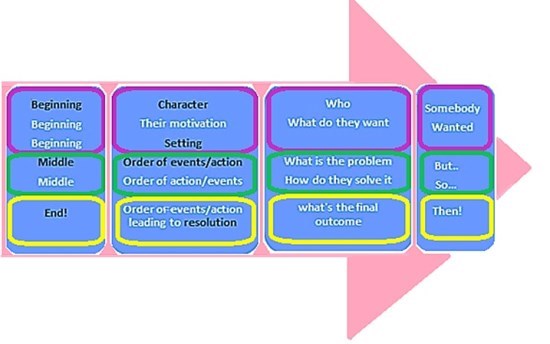
There are many aspects of story-writing to delve into, such as who’s perspective is the story being told; the use of language and imagery, how to show the reader what is going on so that they experience the action, how to flesh-out a story with interesting detail and convey emotions. This blog is an at-a-glance guide that focuses on the key components of a story. There is always a beginning, a middle and an end. Making up the begining is the character, what s/he wants and the setting. Sandwiched in the middle, is the plot or unfolding order of events leading in the end, to a resolution. This is all shown in the first two boxes of the diagram below.
 The 3rd box further breaks down, as questions, what writers must ask themselves to develop and move the story along. The final box (primarily for younger writers), simplifies these aspects of a story — as scaffolding made up of 5 prompts.
The 3rd box further breaks down, as questions, what writers must ask themselves to develop and move the story along. The final box (primarily for younger writers), simplifies these aspects of a story — as scaffolding made up of 5 prompts.
'Somebody' refers to the main character/s of the story. 'Wanted' prompts the writer to think about what the main character wants (which is also the main purpose of the story). 'But' provides a cue for the writer to create an obstacle or problem that the main character must face. 'So' is a prompt to describe how the character/s overcome this problem and achieve what they want. Finally, 'then' should describe what happens in the end, (how everything turns out).
What and how much should a writer tell the reader is also important to the story and needs clarifying. For general fiction, a good guideline to follow is to use simple and quick explanations whenever possible. In other words, the beginning of a story requires the most explanations, while introducing new characters and indicating their relationship to the protagonist or other main characters. To bring the story to life or help the reader imagine it in their minds involves a careful balance (with enough detail), between showing and telling how the characters and events unfold.
Is there more than one type of telling? Exposition is information the reader needs to know, but it doesn't contribute to moving the story along. Narrative is information the reader needs to know (to make sense of what is happening in the story) and DOES contribute to moving the story along to some degree. Keeping a balance between giving the reader information that they need and allowing them to work out meanings and nuances for themselves requires practise. Let the reader discover the story (including history, past events), through the actions of the character/s as much as possible.
References
http://www.absolutewrite.com/novels/exposition_vs_narrative.htm
http://www.creativehat.com/filmmaking/a060600a.htm
http://hearwritenow.com